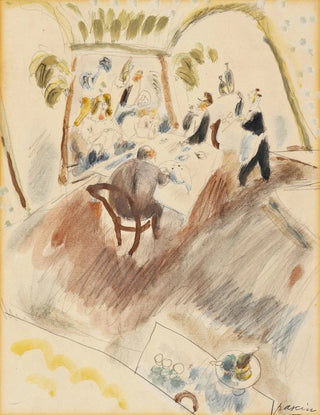Art print | Two Men Dining - Jules Pascin


View from behind

Frame (optional)
The artwork "Two Men Dining" by Jules Pascin invites you to immerse yourself in the intimacy of a moment frozen in time. This painting, both simple and complex, depicts a convivial scene where everyday life blends with art. Through this representation, Pascin transports us to a universe where emotions and human interactions are highlighted. The viewer's gaze is instantly captivated by the warmth of the colors and the depth of the expressions, revealing the very essence of life. This piece is a true testament to art's ability to immortalize fleeting moments while prompting reflection on the nature of human relationships.
Style and uniqueness of the work
Jules Pascin's style is characterized by a subtle fusion of Impressionism and Expressionism, creating a unique atmosphere that is entirely his own. In "Two Men Dining," the contours of the figures are delicately sketched, while the colors blend harmoniously, evoking a sense of movement and vitality. The artist plays with light and shadow to highlight the faces of the characters, emphasizing their complicity and engagement in the exchange that unites them. This work does not merely depict a dining scene; it evokes an ambiance, a palpable emotion that resonates within each of us. Every detail, from the choice of colors to the overall composition, demonstrates Pascin's skill in creating an atmosphere that is both intimate and universal, where the viewer can project themselves and feel the magic of the moment.
The artist and his influence
Jules Pascin, born in Bulgaria and raised amidst the artistic fervor of Paris in the early 20th century, is an emblematic figure of the modernist movement. His unconventional path and diverse influences, ranging from academic painting to avant-garde currents, shaped his distinctive style. Pascin captured the essence of Parisian life, from café scenes to moments of solitude, while incorporating elements of his native culture. His work influenced many contemporary artists, notably through his approach to the human figure and social relationships. By exploring themes of love, of the

Matte finish

View from behind

Frame (optional)
The artwork "Two Men Dining" by Jules Pascin invites you to immerse yourself in the intimacy of a moment frozen in time. This painting, both simple and complex, depicts a convivial scene where everyday life blends with art. Through this representation, Pascin transports us to a universe where emotions and human interactions are highlighted. The viewer's gaze is instantly captivated by the warmth of the colors and the depth of the expressions, revealing the very essence of life. This piece is a true testament to art's ability to immortalize fleeting moments while prompting reflection on the nature of human relationships.
Style and uniqueness of the work
Jules Pascin's style is characterized by a subtle fusion of Impressionism and Expressionism, creating a unique atmosphere that is entirely his own. In "Two Men Dining," the contours of the figures are delicately sketched, while the colors blend harmoniously, evoking a sense of movement and vitality. The artist plays with light and shadow to highlight the faces of the characters, emphasizing their complicity and engagement in the exchange that unites them. This work does not merely depict a dining scene; it evokes an ambiance, a palpable emotion that resonates within each of us. Every detail, from the choice of colors to the overall composition, demonstrates Pascin's skill in creating an atmosphere that is both intimate and universal, where the viewer can project themselves and feel the magic of the moment.
The artist and his influence
Jules Pascin, born in Bulgaria and raised amidst the artistic fervor of Paris in the early 20th century, is an emblematic figure of the modernist movement. His unconventional path and diverse influences, ranging from academic painting to avant-garde currents, shaped his distinctive style. Pascin captured the essence of Parisian life, from café scenes to moments of solitude, while incorporating elements of his native culture. His work influenced many contemporary artists, notably through his approach to the human figure and social relationships. By exploring themes of love, of the






